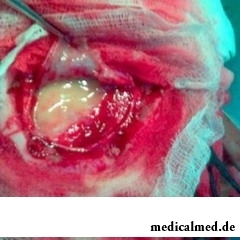





Brain abscess
Abscess of a brain is accumulation of pus in a skull of the person. The disease has limited character.
Types of abscesses of a brain
Abscesses  of a brain happen three types:
of a brain happen three types:
- intracerebral (accumulate in the form of pus in marrow);
- epidural (are located over a firm cover of a brain);
- subdural (are localized under a firm cover of a brain).
Origins of abscesses of a brain
The infection gets into a skull the next ways:
- through a wound during neurosurgical intervention;
- through an open craniocereberal injury;
- gematogenno;
- through pyoinflammatory processes on average and inner ear, adnexal nasal bosoms.
Those brain abscesses which form after neurosurgical intervention in time of meningitis and вентрикул arise because of complications of intracranial and infectious character. Generally they appear only at people with extremely weakened immunity.
At an open craniocereberal injury of the getting character abscesses develop because of hit in an infection skull. Very often these abscesses are observed at the people who are involved in fighting because of the gunshot wounds or wounds caused by explosions min.
Hematogenous abscesses of a brain arise because of a bronchoectatic disease, abscesses of a lung, chronic pneumonia, an empyema of a pleura or other pulmonary inflammatory processes. Sometimes developing of abscess is also promoted by infections in digestive tract, sepsis, a bacterial endocarditis of acute or chronic character. The infection gets on a circulatory bed from a vessel in the inflammatory center to brain vessels where it is fixed in a capillary, a precapillary or an arteriole and leads to development of abscess.
If there are sinusitis and pyoinflammatory processes in an inner or middle ear, then the infection can extend in two ways: to get directly through a firm meninx or on sine of a firm cover and veins of a brain. The second way call retrograde, and in the first case the inflammation at first arises in brain covers but only then passes into adjacent department of a brain.
Clinic
The clinic of abscesses of a brain is very similar to clinic of volume educations which symptoms begin with a headache and come to an end with the hardest all-brain symptoms during which consciousness is oppressed and the brain is surprised. The symptomatology accrues progrediyentno. At initial stages of a disease there can be an epileptiform attack. At subdural processes and an empyema meningeal symptoms are observed, and epidural abscesses in a brain on a clinical picture are very similar to osteomyelitis of cranial bones.
Pathogeny and etiology
Brain abscess in four stages forms:
- 1 stage lasts from 1 day to 3 days. There is a development of encephalitis (a limited inflammation of tissues of brain). At this stage to cope with an inflammation it is quite real. It can be resolved as thanks to antibacterial therapy, and is spontaneous.
- 2 stage last from 4 to 9 days. In the center of abscess there is a cavity with pus which increases if abscess not enough protective mechanisms are wrong to treat or in an organism.
- 3 stage last from 10 to 13 days. These days around the center with pus the protective capsule which consists of connecting fabric is formed. This capsule does not allow to extend to purulent process.
- 4 stage are the 3rd week. To this term the capsule was finally condensed and around it the gliosis zone was created. The further situation depends on reactivity of an organism, virulence of flora and efficiency of treatment. At this stage inflammation involution is still possible, but often it only increases and the new centers of an inflammation around the protective capsule appear.
Activators most often are streptococci, sometimes also with accession of bakteriotid (Bacteroides spp.). Otogenic and hematogenous abscesses of a brain cause Enterobacteriaceae. If the open craniocereberal injury of the getting character is an origin of abscess, then find staphylococcus (St. Aureus) and, sometimes, Enterobacteriaceae. After immunodepressive therapies (transplantation of fabrics and bodies), and also at HIV infection in abscess find Aspergillus fumigatus. But it is quite frequent (in 25-30% of cases) it is impossible to define the activator as crops are sterile.
most often are streptococci, sometimes also with accession of bakteriotid (Bacteroides spp.). Otogenic and hematogenous abscesses of a brain cause Enterobacteriaceae. If the open craniocereberal injury of the getting character is an origin of abscess, then find staphylococcus (St. Aureus) and, sometimes, Enterobacteriaceae. After immunodepressive therapies (transplantation of fabrics and bodies), and also at HIV infection in abscess find Aspergillus fumigatus. But it is quite frequent (in 25-30% of cases) it is impossible to define the activator as crops are sterile.
Treatment of abscesses of a brain
Depending on localization, the sizes and a stage of development treatment of abscesses of a brain can be conservative and surgical.
Up to two weeks, and also at small abscesses (to 3 cm) treatment often conservative is also made by means of empirical antibacterial therapy. The stereotaxic biopsy can be also applied to final treatment.
If because of abscesses dislocation of a brain is caused, intracranial pressure increases or they are in a zone of ventricular system that often has a lethal outcome, treatment is made only by means of surgical intervention. Treatment of abscesses of a brain of fungal character also is surgical.
If abscesses are located in the vital and deep brain structures (in a brainstem, a visual bugor or subcrustal kernels) surgical intervention is contraindicated. In such situations apply stereotaxic treatment: puncture of brain abscess. Further the cavity is washed out and administer the antibacterial drugs. Can wash out once or repeatedly (by means of the catheter established for several days).
Surgical treatment of abscesses of a brain is absolutely forbidden if the patient is in critical condition (in a terminal coma).
Prevention of a disease
Prevention of developing of abscesses in a brain is high-quality and timely treatment of inflammatory processes at initial stages. Prevention of emergence of abscess at a craniocereberal injury is full preprocessing of a wound.
Caries is the most widespread infectious disease in the world to which even flu cannot compete.

No, probably, the person who would not have cold. Cold, cough, a headache – these symptoms are known to everyone. Peak to Prost...
Section: Articles about health
The phenomenon of the panic attack is known long ago, but the reasons of its emergence still are up to the end not found out. It is established that more than 30% of people at least once in life become the victims of very unpleasant phenomenon: without everyones on that the reasons they have a feeling of horror, with...
Section: Articles about health
You are office worker, the driver, the fan of winter sports or do not think of life without bicycle? You lead a slow-moving life and you move on the city only on the car? You have no constant partner and you do not love the protected sex? Attention! You unambiguously are a potential target for prostatitis. It is not necessary to panic, it is necessary to work....
Section: Articles about health
Sometimes it seems that modern society was divided into two camps: representatives of the first are sure that has to for contraception отвеч...
Section: Articles about health
All are familiar with cold, and practically everyone believes that he has sufficient knowledge and experience that correctly to treat it. In practice most of people makes mistakes in attempts to get rid of rhinitis, and divides numerous delusions it....
Section: Articles about health
The word "onikhokriptoz" is unfamiliar to most of people, meanwhile quite so physicians call very widespread problem: the growing of edge of a nail into surrounding fabrics causing inflammatory process. Usually the illness affects thumbs of legs, and is followed by reddening, hypostasis, and in the started cases – release of pus. Patients complain of the pain amplifying when walking, problems with the choice of footwear....
Section: Articles about health
Traveling all over the world, many try to try the most exotic dishes of national cuisines. Exists even so-called died away...
Section: Articles about health
Partial and the more so full loss of hearing significantly reduces quality of life. Difficulties with communication lead to loneliness and isolation. The person who badly hears experiences difficulties with social and professional implementation, quite often has problems in...
Section: Articles about health
You heard that laughter prolongs life? Researchers did not manage to establish longevity direct link with sincere fun yet, but several facts confirming beneficial influence of risibility on the state of health are clinically proved....
Section: Articles about health
For anybody not a secret that the modern person eats not as his ancestors. For the last 100 years in broad access appeared with...
Section: Articles about health
One of the major chemical processes happening in a human body are oxidation reactions. They go with participation of fats and carbohydrates which we receive from food, and the oxygen getting to us from air. A main goal of such reactions is it is received...
Section: Articles about health
Water with a lemon - idle time in preparation drink which supporters of a healthy lifestyle already managed to appreciate. Used in a warm look and on an empty stomach, it is one of the most useful prophylactics allowing to prevent tens of diseases and just to raise an organism tone. Especially effectively to use warm water with lemon juice after a serious illness, during a season of the colds, and also to children, old men and pregnant women which do not have contraindications...
Section: Articles about health
Eyes – unique body on the structure thanks to which the person obtains about 80% of information on the world around: about a form, color, size, the movement, and also many other parameters of objects or phenomena. But whether much we know about the most valuable sense body which, according to the scientist Sechenov, provides us about one thousand various feelings a minute? Let's consider 10 most surprising facts about eyes and sight....
Section: Articles about health
(Xerostomia) many people consider feeling of a xerostomia small and easily removable inconvenience. This delusion...
Section: Articles about health
Turnip, radish, horse-radish – once these and other products enjoyed wide popularity at our ancestors, being not only the food sating an organism but also the medicines curing of many diseases. Unfortunately, having given the use of some of them...
Section: Articles about health
Memory is an ability of the central nervous system to fix, keep and as necessary to reproduce information on knowledge or skills received by the person or an animal during life. The mechanism of this process is up to the end not studied....
Section: Articles about health
Cold, puffiness of a nose, itch, the watering eyes - characteristic symptoms of the allergic rhinitis resulting from hit and...
Section: Articles about health
Milk and products of its processing by right occupy one of the main places in a diet of the modern person. They contain proteins, necessary for normal life activity, fats, vitamins and microelements, and are an important part of various medical diets....
Section: Articles about health
Practice of use of table salt in the therapeutic purposes contains not one century. Applications which do by means of the fabric impregnated with saline solution are considered especially effective. They have antibacterial and antiinflammatory effect, help to heal wounds, exempt fabrics from excess liquid. Hypertonic salt solution of potassium chloride is applied outwardly at many morbid conditions. Let's tell about the most known of them....
Section: Articles about health
Dogrose – one of the most widespread adornment and medicinal plants growing practically in all territory ours...
Section: Articles about health
Osteoporosis this general disease which main sign is decrease in density of a bone tissue. On distribution width it takes the fourth place among noninfectious diseases. The illness develops at mature age more often: in our country to them harvest seasons...
Section: Articles about health
The dietology, as well as other sciences, does not stand still. Food stuffs are exposed to comprehensive study, and scientists obtain new information on their properties and influence on a human body. Unfortunately, this reasonable and natural process gives unpleasant side effect from time to time: some types of food periodically declare "harmful" or even "deadly" without the bases, sufficient on that....
Section: Articles about health
For the help to doctors in the choice of optimal solutions for treatment of various diseases the Cochrane scientific organization (Cochrane) will see off совм...
Section: Articles about health
Coffee - the tonic loved by many for the invigorating aroma and deep taste. Having the stimulating effect, coffee increases working capacity, promotes concentration of attention, fights against drowsiness and improves mood. Statistically, about 30% of inhabitants...
Section: Articles about health
Not without reason doctors say that 90% of diseases begin or develop because of misoperation of intestines. Disturbance of its functions is connected with various factors among which the important place belongs to excessive "clutter" of an intestinal path. In an organism not only the remains of food, but also mass of harmful substances which we with food accepted accumulate. Accepted to accept, and about that to remove them, did not take care. And in it a problem....
Section: Articles about health


